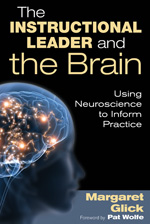Foreword by Pat Wolfe
Preface - Brain Compatible Instructional Leadership
Acknowledgments
About the Author
Instructional Leaders
Knowledge and Skills
Why This Book? Why Now?
What Makes This Book Unique?
Organization of the Book
1. A Brain Primer – Major Structures and Their Functions
Brain Hemispheres
The Cortex
The Cerebellum
Brainstem
Lobes of the Brain
Frontal Lobes
Parietal Lobes
Motor Strip
Somatosensory Strip
Temporal Lobes
Occipital Lobes
Cellular Brain
Plasticity’s Role in Instructional Leadership
Mindsets and Instructional Leadership
How Might the Instructional Leader Support a Teacher Struggling with these Principles?
Celebrate What You Want to See More Of
Using The Survey
Survey for Brain-Compatible Instructional Leadership
2. Emotions
How Insults Affect Thinking
The Transformative Power of Positive Emotions
How Anxiety Can Curtail Clear Thinking
Neuroscience behind emotions
The Limbic Region – The Role of the Amygdala and Hippocampus
Fast v. Slow Pathway – (Fight or Flight v. Thoughtful Response)
Negative Emotions Impact in a School Setting
Positive Emotions in a School Setting
How to use this as an Instructional Leader
Positive Emotional Valance in a Classroom
Modeling of Healthy Emotional Responses
Language’s Link to Emotions
Emotions and Supervising Teachers
School-wide Structures that Promote Positive Emotional Valance
Professional Development on Emotions – Inform and Teach
Connecting Instructional Leader Knowledge and Skill Sets to Emotions Impact On Learning
Resource Provider
Instructional Resource
Good Communicator
Sample Observation of How a Teacher Embeds the Principle
What are Some of the Things the Teacher did that Exemplified an Understanding of How Emotions Impact Learning?
Ideas for Teachers to Increase EQ in their Classrooms
Class Meetings
Teaching Students About Their Brains
Sam’s Circles
Chapter Summary
Post-Assessment Chapter 2 – Emotions Impact on Learning
Questions for Study Group
3. Attention and Engagement
How does understanding how attention and engagement work help an instructional leader?
Inattention subterfuge
Flow
Attention v. Engagement
Attention and Engagement Similarities
Attention
Engagement
ADD/ADHD and Attention
Qualities of Engaging Work
Personal Response
Personal response in the Classroom
Personal response in the Staffroom
Clear Models
Clear Models in the Classroom
Clear Models in the Staffroom
Emotional Safety
Emotional Safety in the Classroom
Emotional Safety in the Staffroom
Intellectual Safety
Intellectual Safety in the Classroom
Intellectual Safety in the Staffroom
Learning With Others
Learning with Others in the Classroom
Learning with Others in the Staffroom
Feedback
Feedback in the Classroom
Feedback in the Staffroom
Sense of Audience
Sense of Audience in the Classroom
Sense of Audience in the Staffroom
Choice
Choice in the Classroom
Choice in the Staffroom
Variety
Variety in the Classroom
Variety in the Staffroom
Authenticity
Authenticity in the Classroom
Authenticity in the Staffroom
Rigor
Rigor in the Classroom
Rigor in the Staffroom
Sense of Competence
Sense of Competence in the Classroom
Sense of Competence in the Staffroom
Meaning and Relevance
Meaning and Relevance in the Classroom
Meaning and Relevance in the Staffroom
Connecting Instructional Leader Knowledge and Skill Sets to Attention and Engagement
Resource Provider
Instructional Resource
Good Communicator
Professional Development for Attention and Engagement
What to Look For in a Lesson Plan?
Sample Observation of a Teacher who Understands the Principle
What are some of the Things the Teacher Did to Take Advantage of Attention and Engagement?
Chapter Summary
Post Assessment Chapter 3 – Attention and Engagement
Questions for Study Group
4. The Power Processing
The Effects of Sensory Overload on Processing
Things that Inhibit Processing
Processing that Seems Effortless
Two Filters to Consider – Relevance and Environment
The Neuroscience Behind Processing – An Analogy
Brain Structures, Functions and Processing
Planning for Processing
Results of Effective Processing
What to Look For in Classrooms: Student Processing
The Use of Multiple Modalities
The Use of Specific Structures that Enhance Processing
Thinking Maps
Classroom Structures that Aid Processing
Using Drawing for Processing
Kinesthetic Structures for Processing
Computer-Assisted Processing
Time for Processing
Proof of Processing
Promising Practices with Professional Development
What to Look for In a Lesson Plan
Lesson Plans, Unit Plans and Curriculum that Attends to Processing
Connecting Instructional Leader Knowledge and Skill Sets to Understanding Processing
Resource Provider
Instructional Resource
Good Communicator
Sample Observation of How a Teacher Embeds the Principle
What are some of the Things the Teacher did to Take Advantage of How We Process?
Chapter Summary
Post Assessment Chapter 4 – The Power of Processing
Questions for Study Group
5. Feedback
How Understanding Feedback Helps the Instructional Leader
Untimely Feedback
Feedback that Encourages and Motivates
What is Feedback?
What’s Going on in Our Brains During Feedback?
Tight and Loose Feedback
Correlation Between Amount of Feedback and Distance to Learning Goal
Different Kinds of Feedback
Written Feedback
Demonstration for Feedback
Elements of Effective Feedback
Emotional Valance of Feedback
Feedback in the Staffroom
Giving Feedback on Instruction
Feedback Regarding Professionalism
Methods of Feedback in Classrooms
Rubrics are Brain-Compatible
Models for Feedback
Using Rubrics for Feedback With Teachers
What to Look for in the Classroom
Student to Student Feedback
Learning Progressions
Feedback During Instruction
Individual White Boards and Feedback
Student Response Systems
I-Clickers
Five-Finger Rubrics
The Magic of the Dot
Checklist Provide Feedback
Reflections for Feedback
Professional Development for Teaching About Feedback
What to Look for in a Lesson Plan
Connecting Instructional Leader Knowledge and Skill Sets to Understanding Feedback
Resource Provider
Instructional Resource
Good Communicator
Sample Observation of How a Teacher Embeds the Principle
What Are Some of the Things the Teacher Did to Take Advantage of Giving and Getting Feedback?
Chapter Summary
Post Assessment Chapter 5 – Feedback
Questions for Study Group
6. Memory
How Understanding How Memory Works Helps the Instructional Leader
Unconscious Memory
Remembering – Even When You Don’t Want To
Remembering After Decades
What is Memory?
Timing Issues
Amount of Information Issue – M-Space and Chunking
How Does Memory Work?
Different Memory Systems – Declarative and Non-Declarative
Declarative Memory
Declarative Memories’ Subgroups – Semantic and Episodic
Semantic Memory
Episodic Memories
Non-Declarative (procedural, emotional, automatic response)
Procedural Memories
Emotional Memories
Automatic Responses
Some Things that Help Us Remember
Why and How do We Forget? The Seven Sins of Memory
Sample Observation of How a Teacher Embeds the Principle
What are Some Things the Teacher Did to Take Advantage of Memory Systems in this Example?
Connecting Instructional Leader Knowledge and Skill Sets to Understanding How Memory Works
Resource Provider
Instructional Resource
Good Communicator
Chapter Summary
Post Assessment Chapter 6 – Memory
Questions for Study Group
Endnote
Index



